Comprehensive Financial Report: Stell Co Ltd Analysis and Review
VerifiedAdded on 2023/06/07
|13
|3032
|58
Report
AI Summary
This report provides a comprehensive financial analysis of Stell Co Ltd, examining its profitability, break-even point, and variance analysis. The report calculates the gross and net profit for 2020 and 2021, along with their respective sales ratios, highlighting a decline in profits and increasing cash flow problems. It explores the reasons for these issues, including reduced sales revenue, increased labor costs, and delayed cash collection. Recommendations are made to improve the financial position, such as online sales, training programs, and early payment discounts. The report also calculates the break-even point using the net contribution method and discusses the advantages and disadvantages of activity-based costing. Furthermore, it calculates sales, direct material, and direct labor variances, analyzes their possible causes and consequences, and recommends implementing a six sigma model and adopting a flexible budget. Lastly, the report evaluates the advantages and disadvantages of switching from incremental-based budgeting to zero-based budgeting.
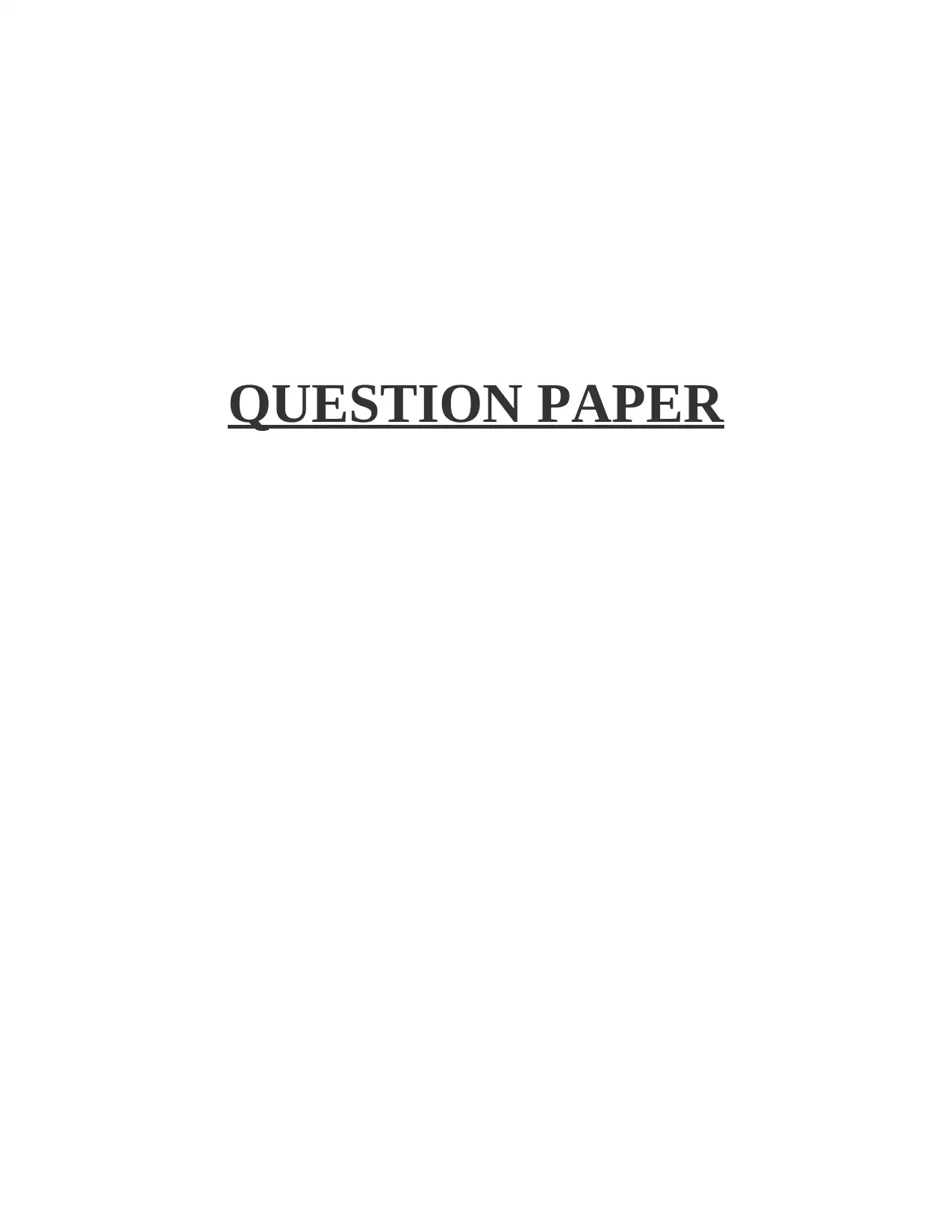
QUESTION PAPER
Paraphrase This Document
Need a fresh take? Get an instant paraphrase of this document with our AI Paraphraser
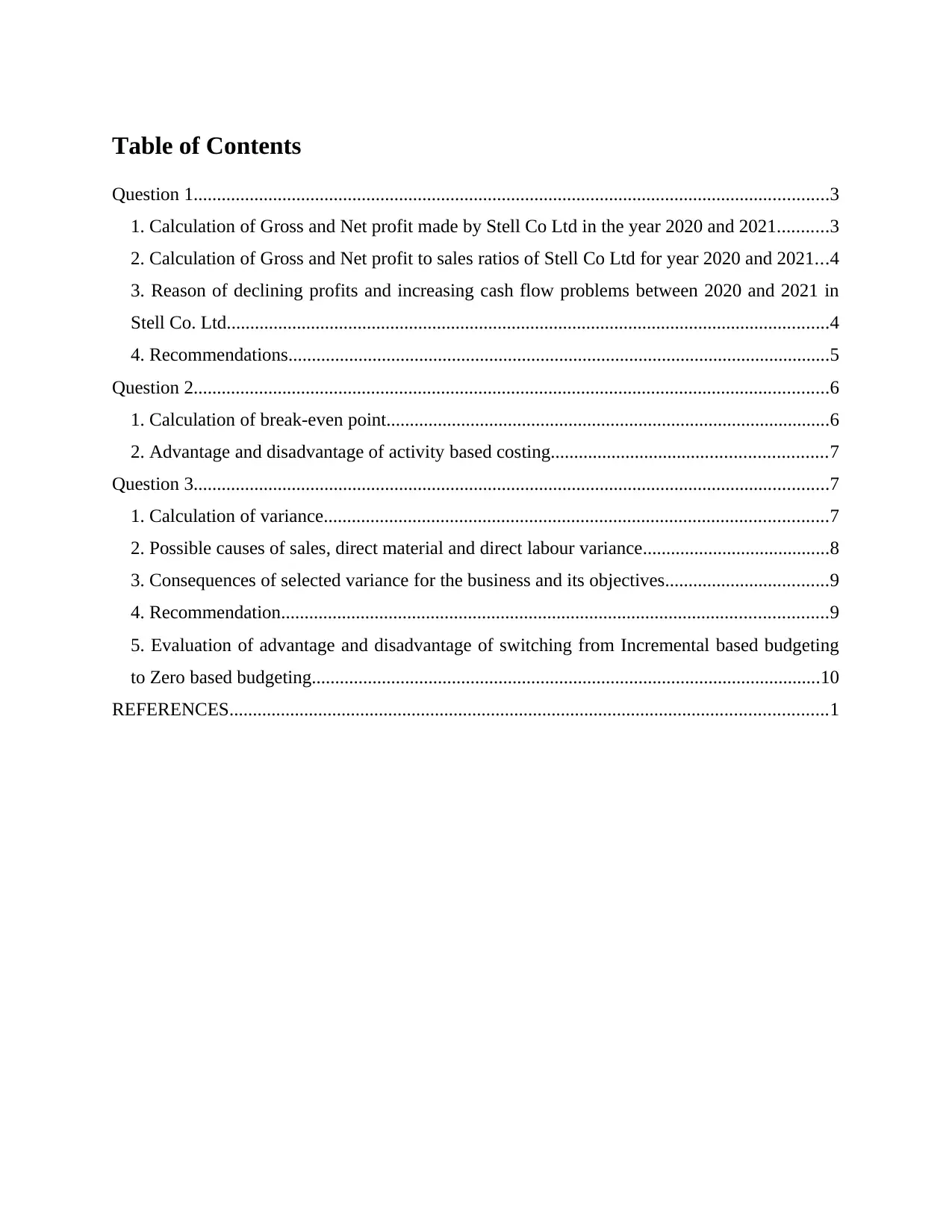
Table of Contents
Question 1........................................................................................................................................3
1. Calculation of Gross and Net profit made by Stell Co Ltd in the year 2020 and 2021...........3
2. Calculation of Gross and Net profit to sales ratios of Stell Co Ltd for year 2020 and 2021...4
3. Reason of declining profits and increasing cash flow problems between 2020 and 2021 in
Stell Co. Ltd.................................................................................................................................4
4. Recommendations....................................................................................................................5
Question 2........................................................................................................................................6
1. Calculation of break-even point...............................................................................................6
2. Advantage and disadvantage of activity based costing...........................................................7
Question 3........................................................................................................................................7
1. Calculation of variance............................................................................................................7
2. Possible causes of sales, direct material and direct labour variance........................................8
3. Consequences of selected variance for the business and its objectives...................................9
4. Recommendation.....................................................................................................................9
5. Evaluation of advantage and disadvantage of switching from Incremental based budgeting
to Zero based budgeting.............................................................................................................10
REFERENCES................................................................................................................................1
Question 1........................................................................................................................................3
1. Calculation of Gross and Net profit made by Stell Co Ltd in the year 2020 and 2021...........3
2. Calculation of Gross and Net profit to sales ratios of Stell Co Ltd for year 2020 and 2021...4
3. Reason of declining profits and increasing cash flow problems between 2020 and 2021 in
Stell Co. Ltd.................................................................................................................................4
4. Recommendations....................................................................................................................5
Question 2........................................................................................................................................6
1. Calculation of break-even point...............................................................................................6
2. Advantage and disadvantage of activity based costing...........................................................7
Question 3........................................................................................................................................7
1. Calculation of variance............................................................................................................7
2. Possible causes of sales, direct material and direct labour variance........................................8
3. Consequences of selected variance for the business and its objectives...................................9
4. Recommendation.....................................................................................................................9
5. Evaluation of advantage and disadvantage of switching from Incremental based budgeting
to Zero based budgeting.............................................................................................................10
REFERENCES................................................................................................................................1
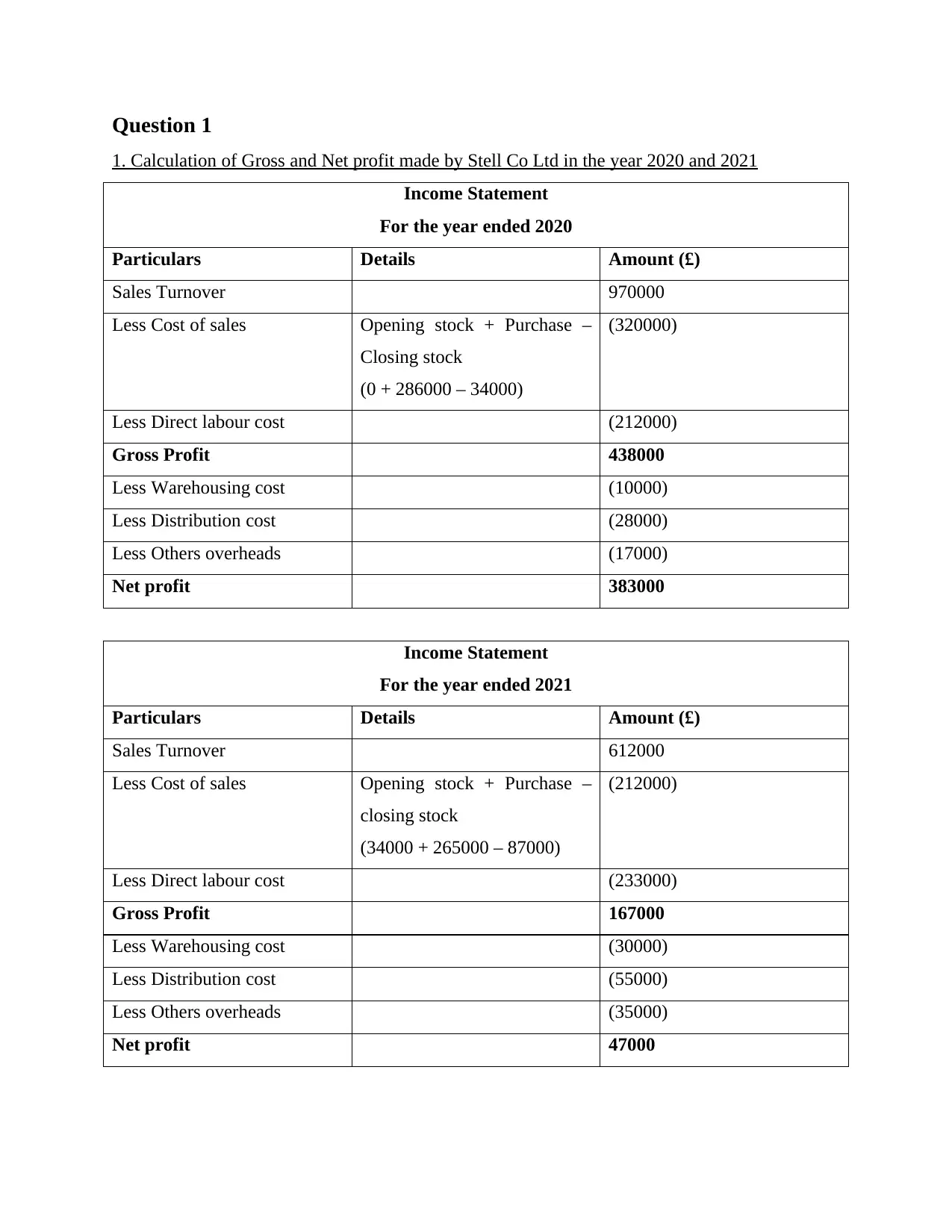
Question 1
1. Calculation of Gross and Net profit made by Stell Co Ltd in the year 2020 and 2021
Income Statement
For the year ended 2020
Particulars Details Amount (£)
Sales Turnover 970000
Less Cost of sales Opening stock + Purchase –
Closing stock
(0 + 286000 – 34000)
(320000)
Less Direct labour cost (212000)
Gross Profit 438000
Less Warehousing cost (10000)
Less Distribution cost (28000)
Less Others overheads (17000)
Net profit 383000
Income Statement
For the year ended 2021
Particulars Details Amount (£)
Sales Turnover 612000
Less Cost of sales Opening stock + Purchase –
closing stock
(34000 + 265000 – 87000)
(212000)
Less Direct labour cost (233000)
Gross Profit 167000
Less Warehousing cost (30000)
Less Distribution cost (55000)
Less Others overheads (35000)
Net profit 47000
1. Calculation of Gross and Net profit made by Stell Co Ltd in the year 2020 and 2021
Income Statement
For the year ended 2020
Particulars Details Amount (£)
Sales Turnover 970000
Less Cost of sales Opening stock + Purchase –
Closing stock
(0 + 286000 – 34000)
(320000)
Less Direct labour cost (212000)
Gross Profit 438000
Less Warehousing cost (10000)
Less Distribution cost (28000)
Less Others overheads (17000)
Net profit 383000
Income Statement
For the year ended 2021
Particulars Details Amount (£)
Sales Turnover 612000
Less Cost of sales Opening stock + Purchase –
closing stock
(34000 + 265000 – 87000)
(212000)
Less Direct labour cost (233000)
Gross Profit 167000
Less Warehousing cost (30000)
Less Distribution cost (55000)
Less Others overheads (35000)
Net profit 47000
⊘ This is a preview!⊘
Do you want full access?
Subscribe today to unlock all pages.

Trusted by 1+ million students worldwide
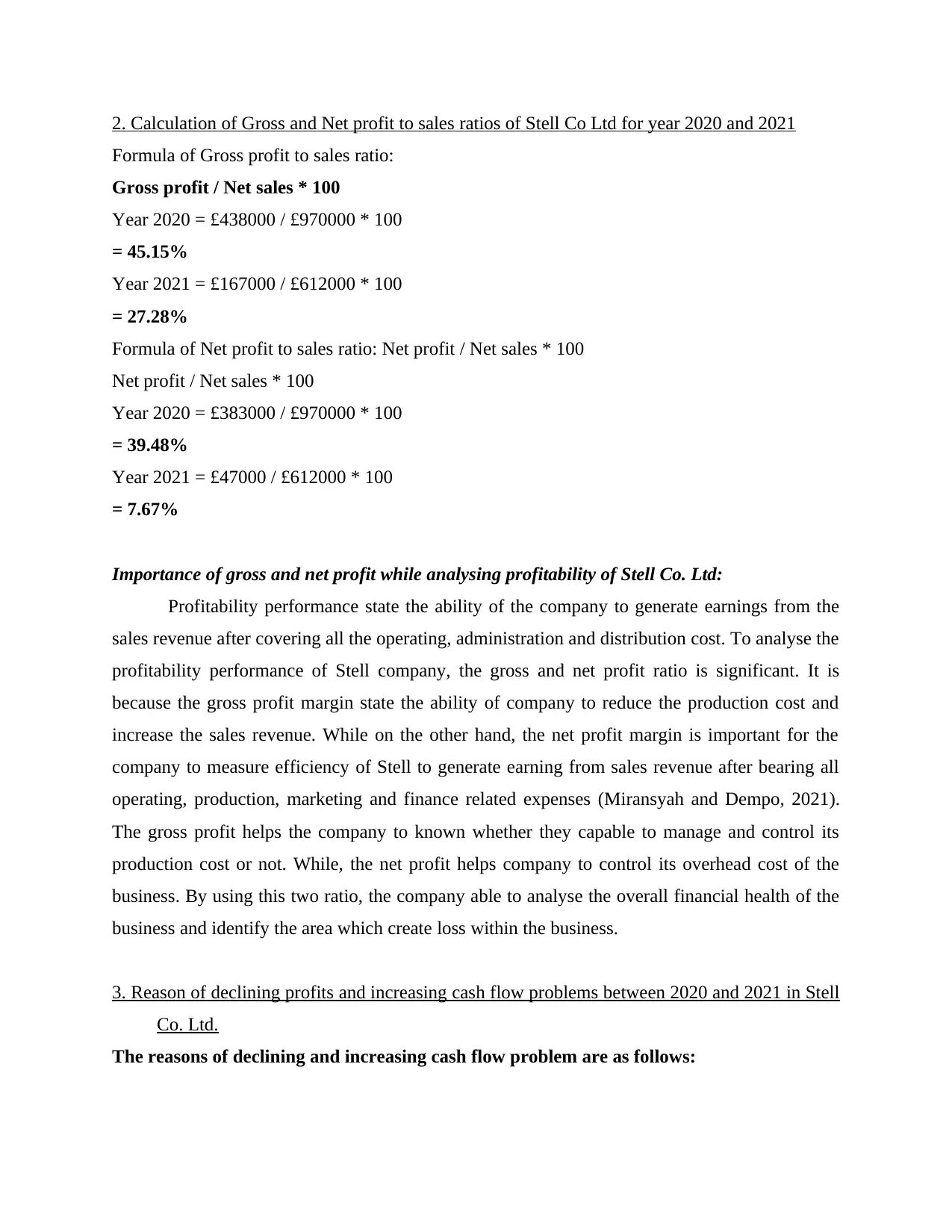
2. Calculation of Gross and Net profit to sales ratios of Stell Co Ltd for year 2020 and 2021
Formula of Gross profit to sales ratio:
Gross profit / Net sales * 100
Year 2020 = £438000 / £970000 * 100
= 45.15%
Year 2021 = £167000 / £612000 * 100
= 27.28%
Formula of Net profit to sales ratio: Net profit / Net sales * 100
Net profit / Net sales * 100
Year 2020 = £383000 / £970000 * 100
= 39.48%
Year 2021 = £47000 / £612000 * 100
= 7.67%
Importance of gross and net profit while analysing profitability of Stell Co. Ltd:
Profitability performance state the ability of the company to generate earnings from the
sales revenue after covering all the operating, administration and distribution cost. To analyse the
profitability performance of Stell company, the gross and net profit ratio is significant. It is
because the gross profit margin state the ability of company to reduce the production cost and
increase the sales revenue. While on the other hand, the net profit margin is important for the
company to measure efficiency of Stell to generate earning from sales revenue after bearing all
operating, production, marketing and finance related expenses (Miransyah and Dempo, 2021).
The gross profit helps the company to known whether they capable to manage and control its
production cost or not. While, the net profit helps company to control its overhead cost of the
business. By using this two ratio, the company able to analyse the overall financial health of the
business and identify the area which create loss within the business.
3. Reason of declining profits and increasing cash flow problems between 2020 and 2021 in Stell
Co. Ltd.
The reasons of declining and increasing cash flow problem are as follows:
Formula of Gross profit to sales ratio:
Gross profit / Net sales * 100
Year 2020 = £438000 / £970000 * 100
= 45.15%
Year 2021 = £167000 / £612000 * 100
= 27.28%
Formula of Net profit to sales ratio: Net profit / Net sales * 100
Net profit / Net sales * 100
Year 2020 = £383000 / £970000 * 100
= 39.48%
Year 2021 = £47000 / £612000 * 100
= 7.67%
Importance of gross and net profit while analysing profitability of Stell Co. Ltd:
Profitability performance state the ability of the company to generate earnings from the
sales revenue after covering all the operating, administration and distribution cost. To analyse the
profitability performance of Stell company, the gross and net profit ratio is significant. It is
because the gross profit margin state the ability of company to reduce the production cost and
increase the sales revenue. While on the other hand, the net profit margin is important for the
company to measure efficiency of Stell to generate earning from sales revenue after bearing all
operating, production, marketing and finance related expenses (Miransyah and Dempo, 2021).
The gross profit helps the company to known whether they capable to manage and control its
production cost or not. While, the net profit helps company to control its overhead cost of the
business. By using this two ratio, the company able to analyse the overall financial health of the
business and identify the area which create loss within the business.
3. Reason of declining profits and increasing cash flow problems between 2020 and 2021 in Stell
Co. Ltd.
The reasons of declining and increasing cash flow problem are as follows:
Paraphrase This Document
Need a fresh take? Get an instant paraphrase of this document with our AI Paraphraser
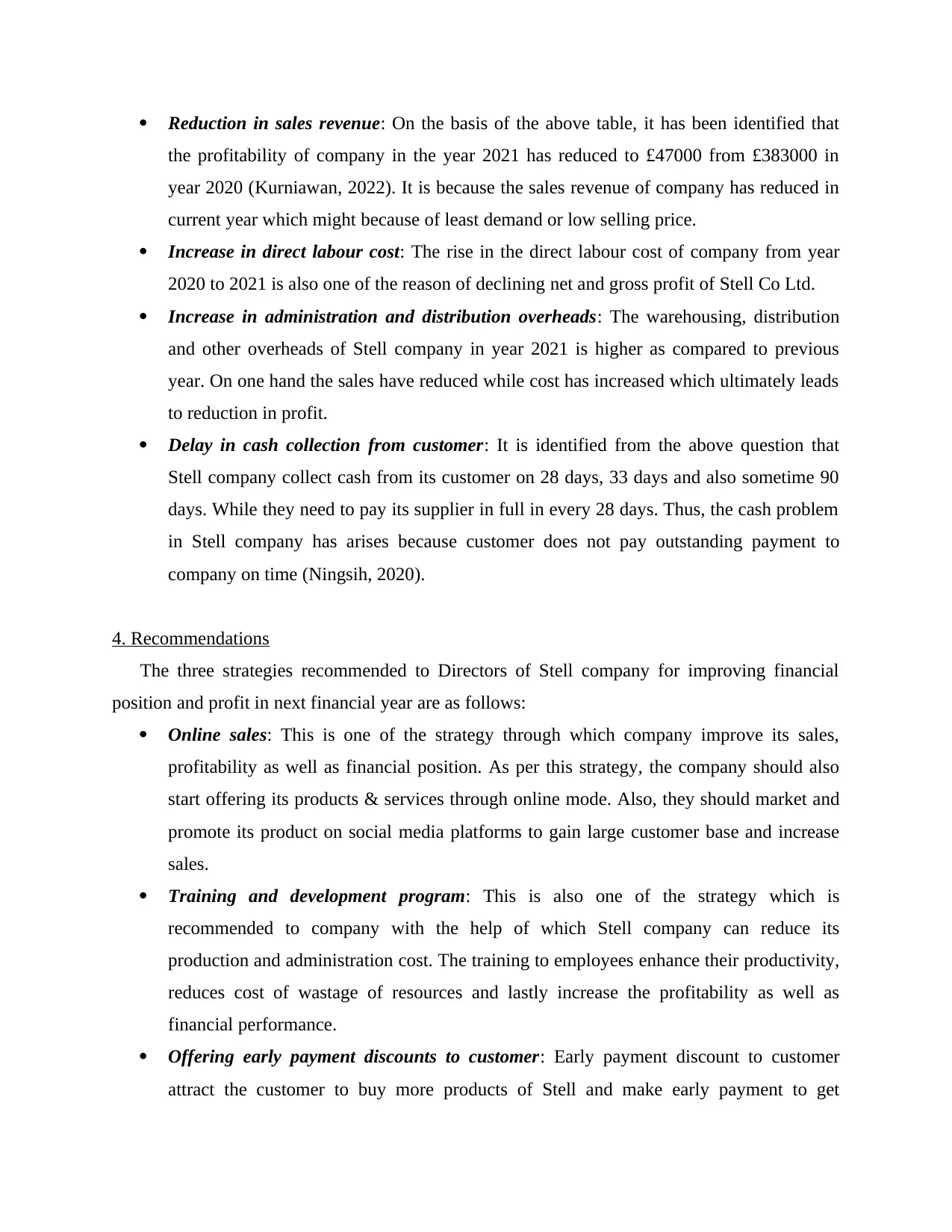
Reduction in sales revenue: On the basis of the above table, it has been identified that
the profitability of company in the year 2021 has reduced to £47000 from £383000 in
year 2020 (Kurniawan, 2022). It is because the sales revenue of company has reduced in
current year which might because of least demand or low selling price.
Increase in direct labour cost: The rise in the direct labour cost of company from year
2020 to 2021 is also one of the reason of declining net and gross profit of Stell Co Ltd.
Increase in administration and distribution overheads: The warehousing, distribution
and other overheads of Stell company in year 2021 is higher as compared to previous
year. On one hand the sales have reduced while cost has increased which ultimately leads
to reduction in profit.
Delay in cash collection from customer: It is identified from the above question that
Stell company collect cash from its customer on 28 days, 33 days and also sometime 90
days. While they need to pay its supplier in full in every 28 days. Thus, the cash problem
in Stell company has arises because customer does not pay outstanding payment to
company on time (Ningsih, 2020).
4. Recommendations
The three strategies recommended to Directors of Stell company for improving financial
position and profit in next financial year are as follows:
Online sales: This is one of the strategy through which company improve its sales,
profitability as well as financial position. As per this strategy, the company should also
start offering its products & services through online mode. Also, they should market and
promote its product on social media platforms to gain large customer base and increase
sales.
Training and development program: This is also one of the strategy which is
recommended to company with the help of which Stell company can reduce its
production and administration cost. The training to employees enhance their productivity,
reduces cost of wastage of resources and lastly increase the profitability as well as
financial performance.
Offering early payment discounts to customer: Early payment discount to customer
attract the customer to buy more products of Stell and make early payment to get
the profitability of company in the year 2021 has reduced to £47000 from £383000 in
year 2020 (Kurniawan, 2022). It is because the sales revenue of company has reduced in
current year which might because of least demand or low selling price.
Increase in direct labour cost: The rise in the direct labour cost of company from year
2020 to 2021 is also one of the reason of declining net and gross profit of Stell Co Ltd.
Increase in administration and distribution overheads: The warehousing, distribution
and other overheads of Stell company in year 2021 is higher as compared to previous
year. On one hand the sales have reduced while cost has increased which ultimately leads
to reduction in profit.
Delay in cash collection from customer: It is identified from the above question that
Stell company collect cash from its customer on 28 days, 33 days and also sometime 90
days. While they need to pay its supplier in full in every 28 days. Thus, the cash problem
in Stell company has arises because customer does not pay outstanding payment to
company on time (Ningsih, 2020).
4. Recommendations
The three strategies recommended to Directors of Stell company for improving financial
position and profit in next financial year are as follows:
Online sales: This is one of the strategy through which company improve its sales,
profitability as well as financial position. As per this strategy, the company should also
start offering its products & services through online mode. Also, they should market and
promote its product on social media platforms to gain large customer base and increase
sales.
Training and development program: This is also one of the strategy which is
recommended to company with the help of which Stell company can reduce its
production and administration cost. The training to employees enhance their productivity,
reduces cost of wastage of resources and lastly increase the profitability as well as
financial performance.
Offering early payment discounts to customer: Early payment discount to customer
attract the customer to buy more products of Stell and make early payment to get
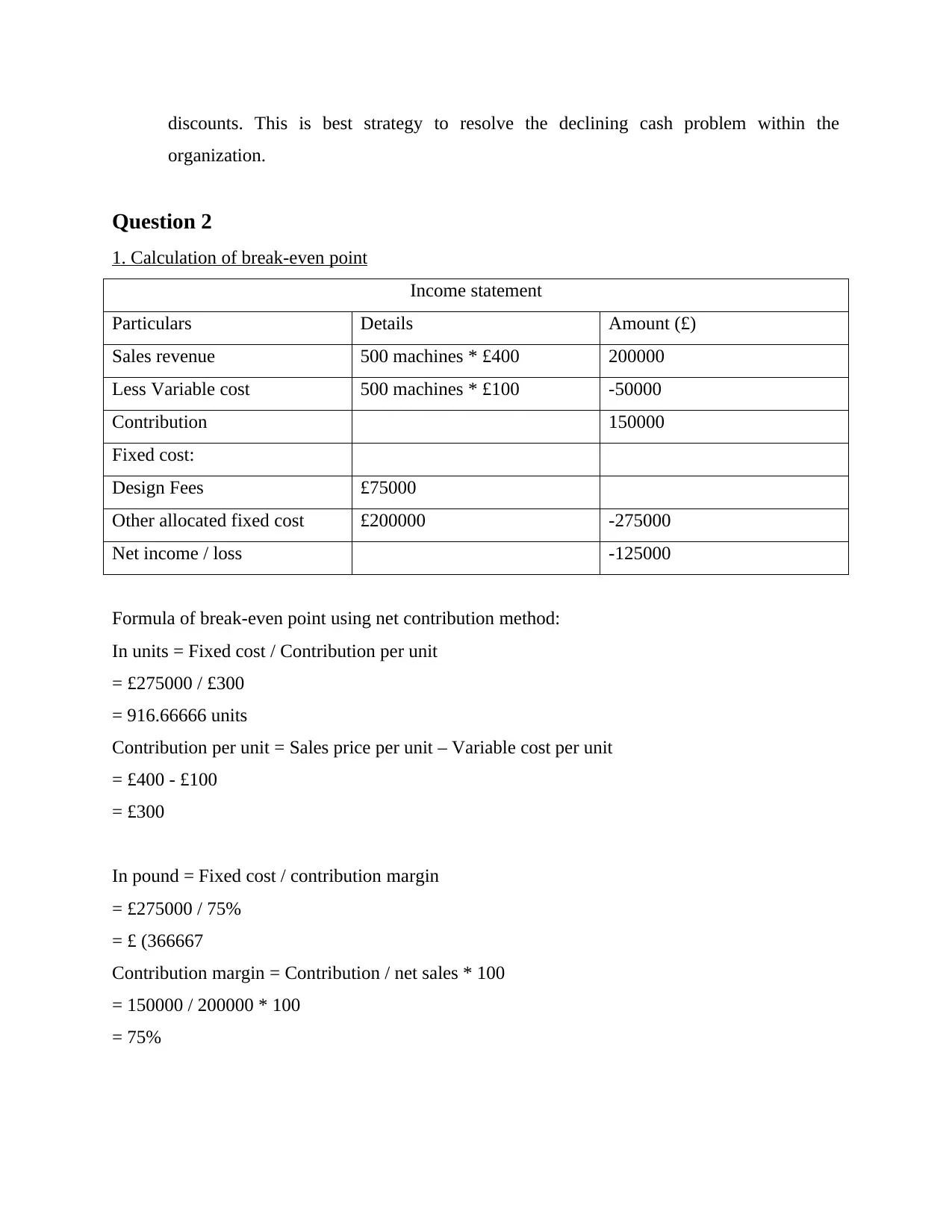
discounts. This is best strategy to resolve the declining cash problem within the
organization.
Question 2
1. Calculation of break-even point
Income statement
Particulars Details Amount (£)
Sales revenue 500 machines * £400 200000
Less Variable cost 500 machines * £100 -50000
Contribution 150000
Fixed cost:
Design Fees £75000
Other allocated fixed cost £200000 -275000
Net income / loss -125000
Formula of break-even point using net contribution method:
In units = Fixed cost / Contribution per unit
= £275000 / £300
= 916.66666 units
Contribution per unit = Sales price per unit – Variable cost per unit
= £400 - £100
= £300
In pound = Fixed cost / contribution margin
= £275000 / 75%
= £ (366667
Contribution margin = Contribution / net sales * 100
= 150000 / 200000 * 100
= 75%
organization.
Question 2
1. Calculation of break-even point
Income statement
Particulars Details Amount (£)
Sales revenue 500 machines * £400 200000
Less Variable cost 500 machines * £100 -50000
Contribution 150000
Fixed cost:
Design Fees £75000
Other allocated fixed cost £200000 -275000
Net income / loss -125000
Formula of break-even point using net contribution method:
In units = Fixed cost / Contribution per unit
= £275000 / £300
= 916.66666 units
Contribution per unit = Sales price per unit – Variable cost per unit
= £400 - £100
= £300
In pound = Fixed cost / contribution margin
= £275000 / 75%
= £ (366667
Contribution margin = Contribution / net sales * 100
= 150000 / 200000 * 100
= 75%
⊘ This is a preview!⊘
Do you want full access?
Subscribe today to unlock all pages.

Trusted by 1+ million students worldwide
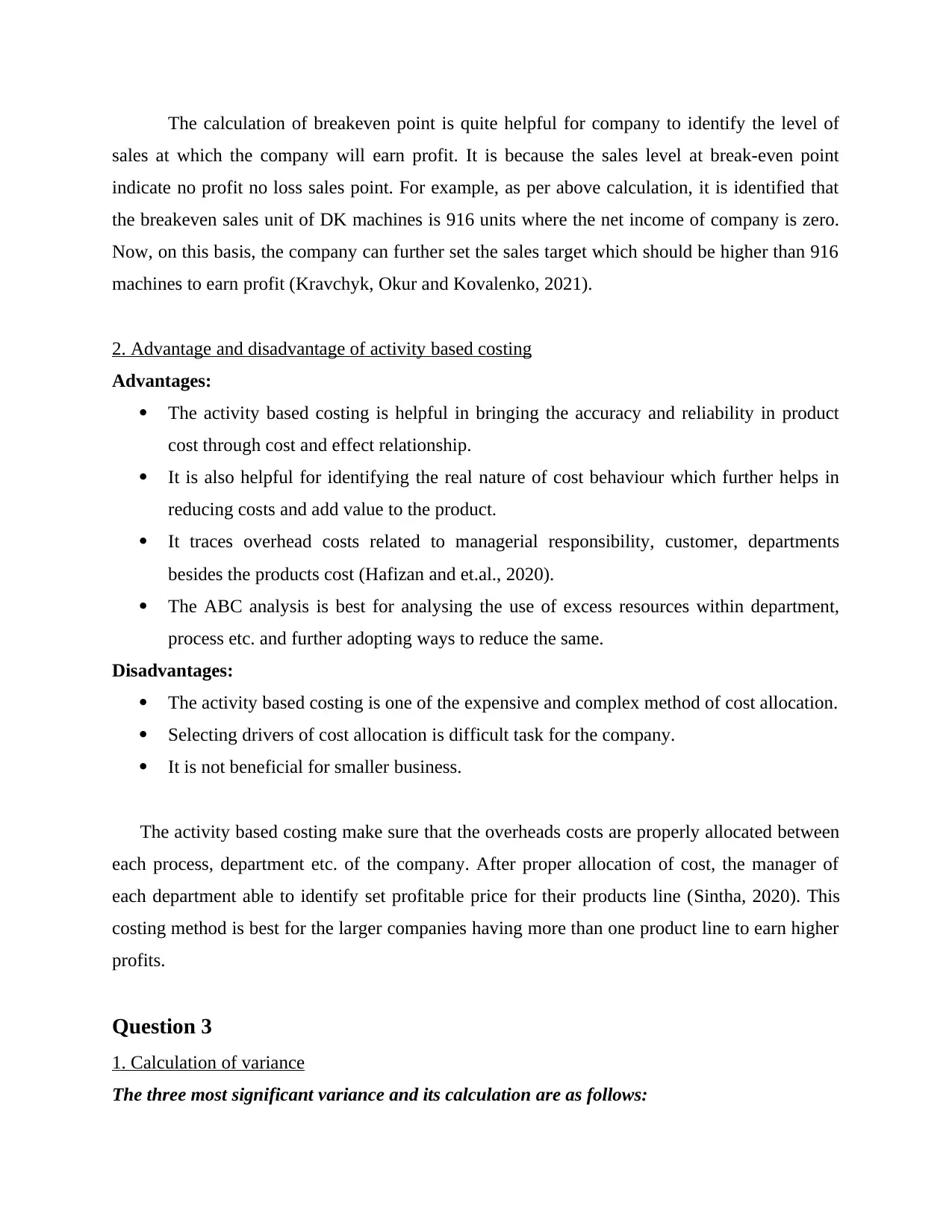
The calculation of breakeven point is quite helpful for company to identify the level of
sales at which the company will earn profit. It is because the sales level at break-even point
indicate no profit no loss sales point. For example, as per above calculation, it is identified that
the breakeven sales unit of DK machines is 916 units where the net income of company is zero.
Now, on this basis, the company can further set the sales target which should be higher than 916
machines to earn profit (Kravchyk, Okur and Kovalenko, 2021).
2. Advantage and disadvantage of activity based costing
Advantages:
The activity based costing is helpful in bringing the accuracy and reliability in product
cost through cost and effect relationship.
It is also helpful for identifying the real nature of cost behaviour which further helps in
reducing costs and add value to the product.
It traces overhead costs related to managerial responsibility, customer, departments
besides the products cost (Hafizan and et.al., 2020).
The ABC analysis is best for analysing the use of excess resources within department,
process etc. and further adopting ways to reduce the same.
Disadvantages:
The activity based costing is one of the expensive and complex method of cost allocation.
Selecting drivers of cost allocation is difficult task for the company.
It is not beneficial for smaller business.
The activity based costing make sure that the overheads costs are properly allocated between
each process, department etc. of the company. After proper allocation of cost, the manager of
each department able to identify set profitable price for their products line (Sintha, 2020). This
costing method is best for the larger companies having more than one product line to earn higher
profits.
Question 3
1. Calculation of variance
The three most significant variance and its calculation are as follows:
sales at which the company will earn profit. It is because the sales level at break-even point
indicate no profit no loss sales point. For example, as per above calculation, it is identified that
the breakeven sales unit of DK machines is 916 units where the net income of company is zero.
Now, on this basis, the company can further set the sales target which should be higher than 916
machines to earn profit (Kravchyk, Okur and Kovalenko, 2021).
2. Advantage and disadvantage of activity based costing
Advantages:
The activity based costing is helpful in bringing the accuracy and reliability in product
cost through cost and effect relationship.
It is also helpful for identifying the real nature of cost behaviour which further helps in
reducing costs and add value to the product.
It traces overhead costs related to managerial responsibility, customer, departments
besides the products cost (Hafizan and et.al., 2020).
The ABC analysis is best for analysing the use of excess resources within department,
process etc. and further adopting ways to reduce the same.
Disadvantages:
The activity based costing is one of the expensive and complex method of cost allocation.
Selecting drivers of cost allocation is difficult task for the company.
It is not beneficial for smaller business.
The activity based costing make sure that the overheads costs are properly allocated between
each process, department etc. of the company. After proper allocation of cost, the manager of
each department able to identify set profitable price for their products line (Sintha, 2020). This
costing method is best for the larger companies having more than one product line to earn higher
profits.
Question 3
1. Calculation of variance
The three most significant variance and its calculation are as follows:
Paraphrase This Document
Need a fresh take? Get an instant paraphrase of this document with our AI Paraphraser
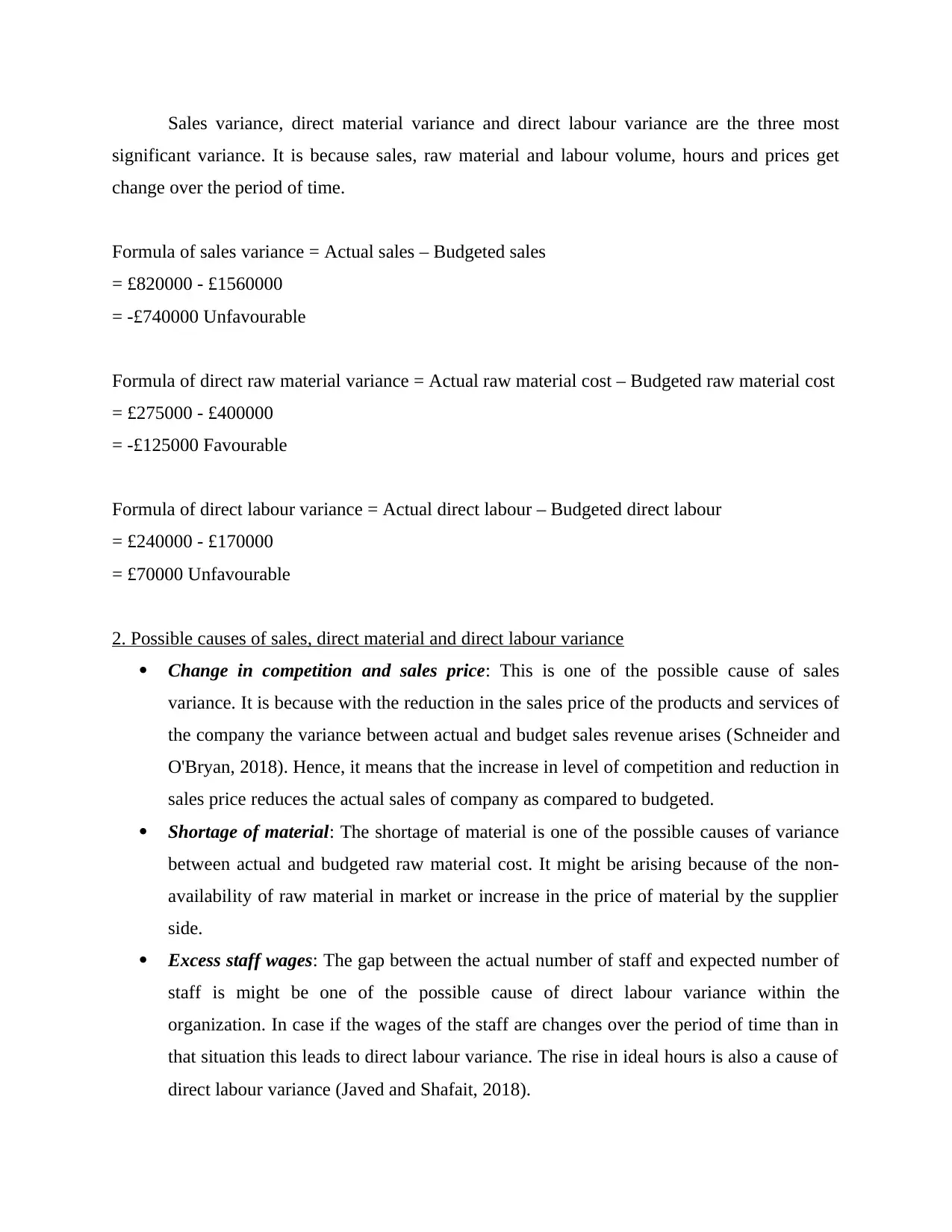
Sales variance, direct material variance and direct labour variance are the three most
significant variance. It is because sales, raw material and labour volume, hours and prices get
change over the period of time.
Formula of sales variance = Actual sales – Budgeted sales
= £820000 - £1560000
= -£740000 Unfavourable
Formula of direct raw material variance = Actual raw material cost – Budgeted raw material cost
= £275000 - £400000
= -£125000 Favourable
Formula of direct labour variance = Actual direct labour – Budgeted direct labour
= £240000 - £170000
= £70000 Unfavourable
2. Possible causes of sales, direct material and direct labour variance
Change in competition and sales price: This is one of the possible cause of sales
variance. It is because with the reduction in the sales price of the products and services of
the company the variance between actual and budget sales revenue arises (Schneider and
O'Bryan, 2018). Hence, it means that the increase in level of competition and reduction in
sales price reduces the actual sales of company as compared to budgeted.
Shortage of material: The shortage of material is one of the possible causes of variance
between actual and budgeted raw material cost. It might be arising because of the non-
availability of raw material in market or increase in the price of material by the supplier
side.
Excess staff wages: The gap between the actual number of staff and expected number of
staff is might be one of the possible cause of direct labour variance within the
organization. In case if the wages of the staff are changes over the period of time than in
that situation this leads to direct labour variance. The rise in ideal hours is also a cause of
direct labour variance (Javed and Shafait, 2018).
significant variance. It is because sales, raw material and labour volume, hours and prices get
change over the period of time.
Formula of sales variance = Actual sales – Budgeted sales
= £820000 - £1560000
= -£740000 Unfavourable
Formula of direct raw material variance = Actual raw material cost – Budgeted raw material cost
= £275000 - £400000
= -£125000 Favourable
Formula of direct labour variance = Actual direct labour – Budgeted direct labour
= £240000 - £170000
= £70000 Unfavourable
2. Possible causes of sales, direct material and direct labour variance
Change in competition and sales price: This is one of the possible cause of sales
variance. It is because with the reduction in the sales price of the products and services of
the company the variance between actual and budget sales revenue arises (Schneider and
O'Bryan, 2018). Hence, it means that the increase in level of competition and reduction in
sales price reduces the actual sales of company as compared to budgeted.
Shortage of material: The shortage of material is one of the possible causes of variance
between actual and budgeted raw material cost. It might be arising because of the non-
availability of raw material in market or increase in the price of material by the supplier
side.
Excess staff wages: The gap between the actual number of staff and expected number of
staff is might be one of the possible cause of direct labour variance within the
organization. In case if the wages of the staff are changes over the period of time than in
that situation this leads to direct labour variance. The rise in ideal hours is also a cause of
direct labour variance (Javed and Shafait, 2018).
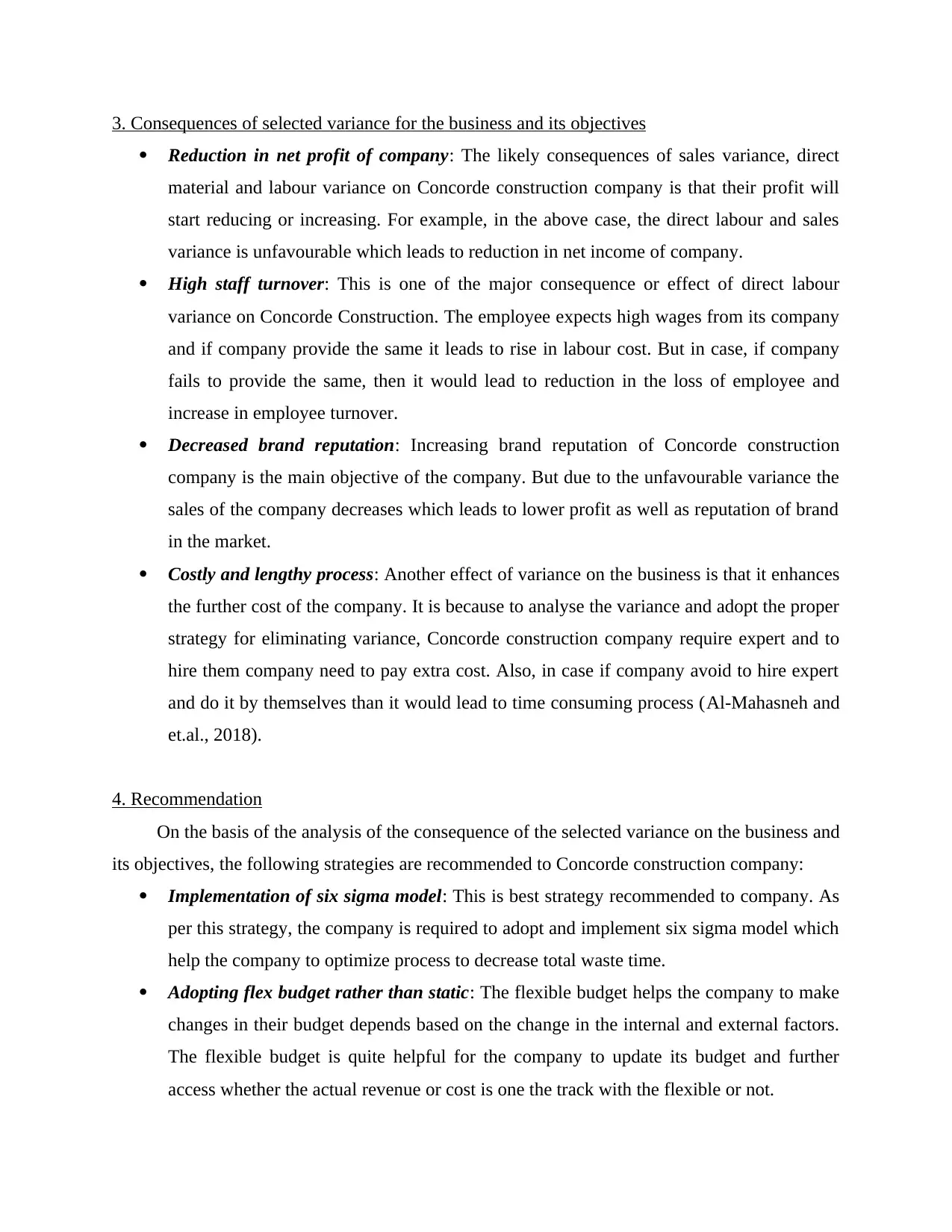
3. Consequences of selected variance for the business and its objectives
Reduction in net profit of company: The likely consequences of sales variance, direct
material and labour variance on Concorde construction company is that their profit will
start reducing or increasing. For example, in the above case, the direct labour and sales
variance is unfavourable which leads to reduction in net income of company.
High staff turnover: This is one of the major consequence or effect of direct labour
variance on Concorde Construction. The employee expects high wages from its company
and if company provide the same it leads to rise in labour cost. But in case, if company
fails to provide the same, then it would lead to reduction in the loss of employee and
increase in employee turnover.
Decreased brand reputation: Increasing brand reputation of Concorde construction
company is the main objective of the company. But due to the unfavourable variance the
sales of the company decreases which leads to lower profit as well as reputation of brand
in the market.
Costly and lengthy process: Another effect of variance on the business is that it enhances
the further cost of the company. It is because to analyse the variance and adopt the proper
strategy for eliminating variance, Concorde construction company require expert and to
hire them company need to pay extra cost. Also, in case if company avoid to hire expert
and do it by themselves than it would lead to time consuming process (Al-Mahasneh and
et.al., 2018).
4. Recommendation
On the basis of the analysis of the consequence of the selected variance on the business and
its objectives, the following strategies are recommended to Concorde construction company:
Implementation of six sigma model: This is best strategy recommended to company. As
per this strategy, the company is required to adopt and implement six sigma model which
help the company to optimize process to decrease total waste time.
Adopting flex budget rather than static: The flexible budget helps the company to make
changes in their budget depends based on the change in the internal and external factors.
The flexible budget is quite helpful for the company to update its budget and further
access whether the actual revenue or cost is one the track with the flexible or not.
Reduction in net profit of company: The likely consequences of sales variance, direct
material and labour variance on Concorde construction company is that their profit will
start reducing or increasing. For example, in the above case, the direct labour and sales
variance is unfavourable which leads to reduction in net income of company.
High staff turnover: This is one of the major consequence or effect of direct labour
variance on Concorde Construction. The employee expects high wages from its company
and if company provide the same it leads to rise in labour cost. But in case, if company
fails to provide the same, then it would lead to reduction in the loss of employee and
increase in employee turnover.
Decreased brand reputation: Increasing brand reputation of Concorde construction
company is the main objective of the company. But due to the unfavourable variance the
sales of the company decreases which leads to lower profit as well as reputation of brand
in the market.
Costly and lengthy process: Another effect of variance on the business is that it enhances
the further cost of the company. It is because to analyse the variance and adopt the proper
strategy for eliminating variance, Concorde construction company require expert and to
hire them company need to pay extra cost. Also, in case if company avoid to hire expert
and do it by themselves than it would lead to time consuming process (Al-Mahasneh and
et.al., 2018).
4. Recommendation
On the basis of the analysis of the consequence of the selected variance on the business and
its objectives, the following strategies are recommended to Concorde construction company:
Implementation of six sigma model: This is best strategy recommended to company. As
per this strategy, the company is required to adopt and implement six sigma model which
help the company to optimize process to decrease total waste time.
Adopting flex budget rather than static: The flexible budget helps the company to make
changes in their budget depends based on the change in the internal and external factors.
The flexible budget is quite helpful for the company to update its budget and further
access whether the actual revenue or cost is one the track with the flexible or not.
⊘ This is a preview!⊘
Do you want full access?
Subscribe today to unlock all pages.

Trusted by 1+ million students worldwide
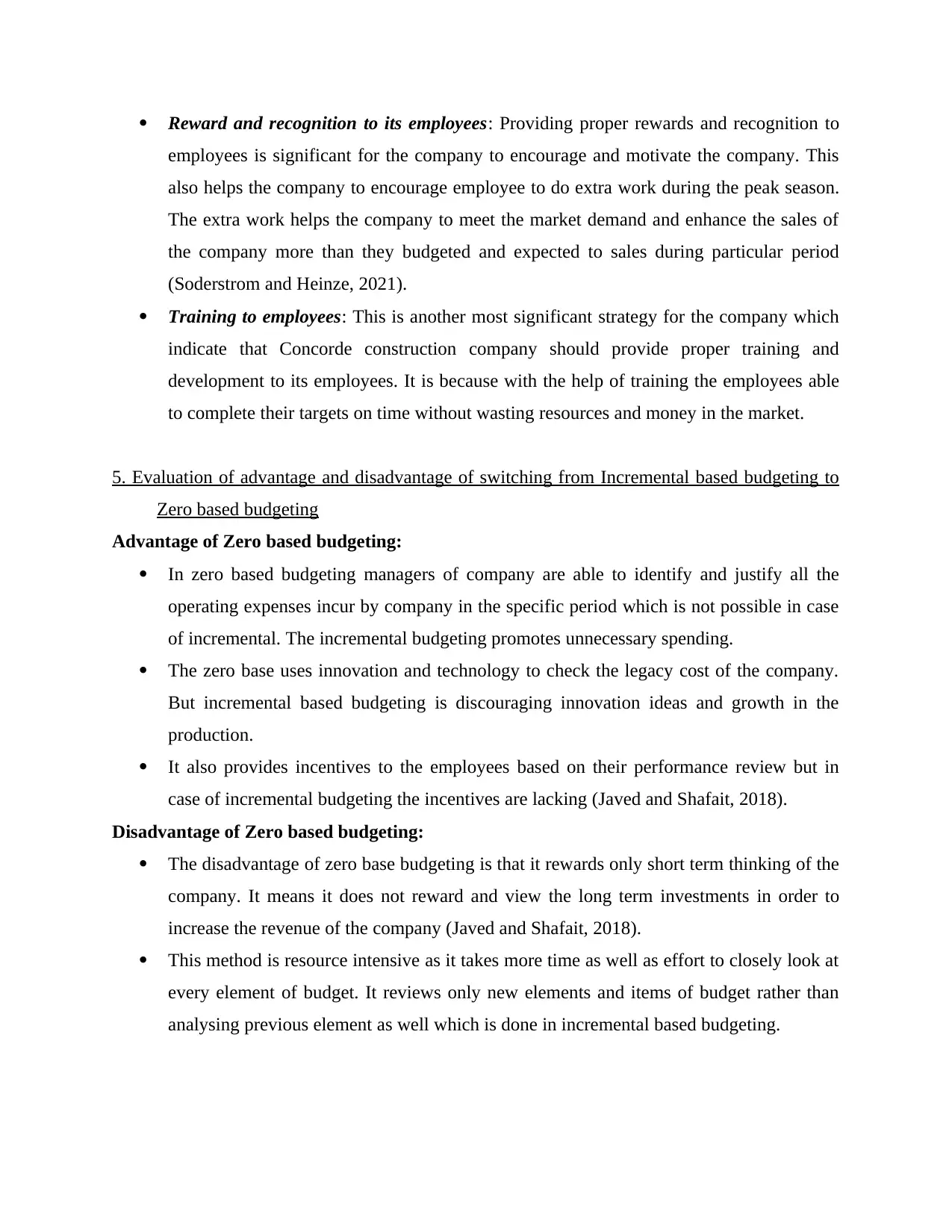
Reward and recognition to its employees: Providing proper rewards and recognition to
employees is significant for the company to encourage and motivate the company. This
also helps the company to encourage employee to do extra work during the peak season.
The extra work helps the company to meet the market demand and enhance the sales of
the company more than they budgeted and expected to sales during particular period
(Soderstrom and Heinze, 2021).
Training to employees: This is another most significant strategy for the company which
indicate that Concorde construction company should provide proper training and
development to its employees. It is because with the help of training the employees able
to complete their targets on time without wasting resources and money in the market.
5. Evaluation of advantage and disadvantage of switching from Incremental based budgeting to
Zero based budgeting
Advantage of Zero based budgeting:
In zero based budgeting managers of company are able to identify and justify all the
operating expenses incur by company in the specific period which is not possible in case
of incremental. The incremental budgeting promotes unnecessary spending.
The zero base uses innovation and technology to check the legacy cost of the company.
But incremental based budgeting is discouraging innovation ideas and growth in the
production.
It also provides incentives to the employees based on their performance review but in
case of incremental budgeting the incentives are lacking (Javed and Shafait, 2018).
Disadvantage of Zero based budgeting:
The disadvantage of zero base budgeting is that it rewards only short term thinking of the
company. It means it does not reward and view the long term investments in order to
increase the revenue of the company (Javed and Shafait, 2018).
This method is resource intensive as it takes more time as well as effort to closely look at
every element of budget. It reviews only new elements and items of budget rather than
analysing previous element as well which is done in incremental based budgeting.
employees is significant for the company to encourage and motivate the company. This
also helps the company to encourage employee to do extra work during the peak season.
The extra work helps the company to meet the market demand and enhance the sales of
the company more than they budgeted and expected to sales during particular period
(Soderstrom and Heinze, 2021).
Training to employees: This is another most significant strategy for the company which
indicate that Concorde construction company should provide proper training and
development to its employees. It is because with the help of training the employees able
to complete their targets on time without wasting resources and money in the market.
5. Evaluation of advantage and disadvantage of switching from Incremental based budgeting to
Zero based budgeting
Advantage of Zero based budgeting:
In zero based budgeting managers of company are able to identify and justify all the
operating expenses incur by company in the specific period which is not possible in case
of incremental. The incremental budgeting promotes unnecessary spending.
The zero base uses innovation and technology to check the legacy cost of the company.
But incremental based budgeting is discouraging innovation ideas and growth in the
production.
It also provides incentives to the employees based on their performance review but in
case of incremental budgeting the incentives are lacking (Javed and Shafait, 2018).
Disadvantage of Zero based budgeting:
The disadvantage of zero base budgeting is that it rewards only short term thinking of the
company. It means it does not reward and view the long term investments in order to
increase the revenue of the company (Javed and Shafait, 2018).
This method is resource intensive as it takes more time as well as effort to closely look at
every element of budget. It reviews only new elements and items of budget rather than
analysing previous element as well which is done in incremental based budgeting.
Paraphrase This Document
Need a fresh take? Get an instant paraphrase of this document with our AI Paraphraser

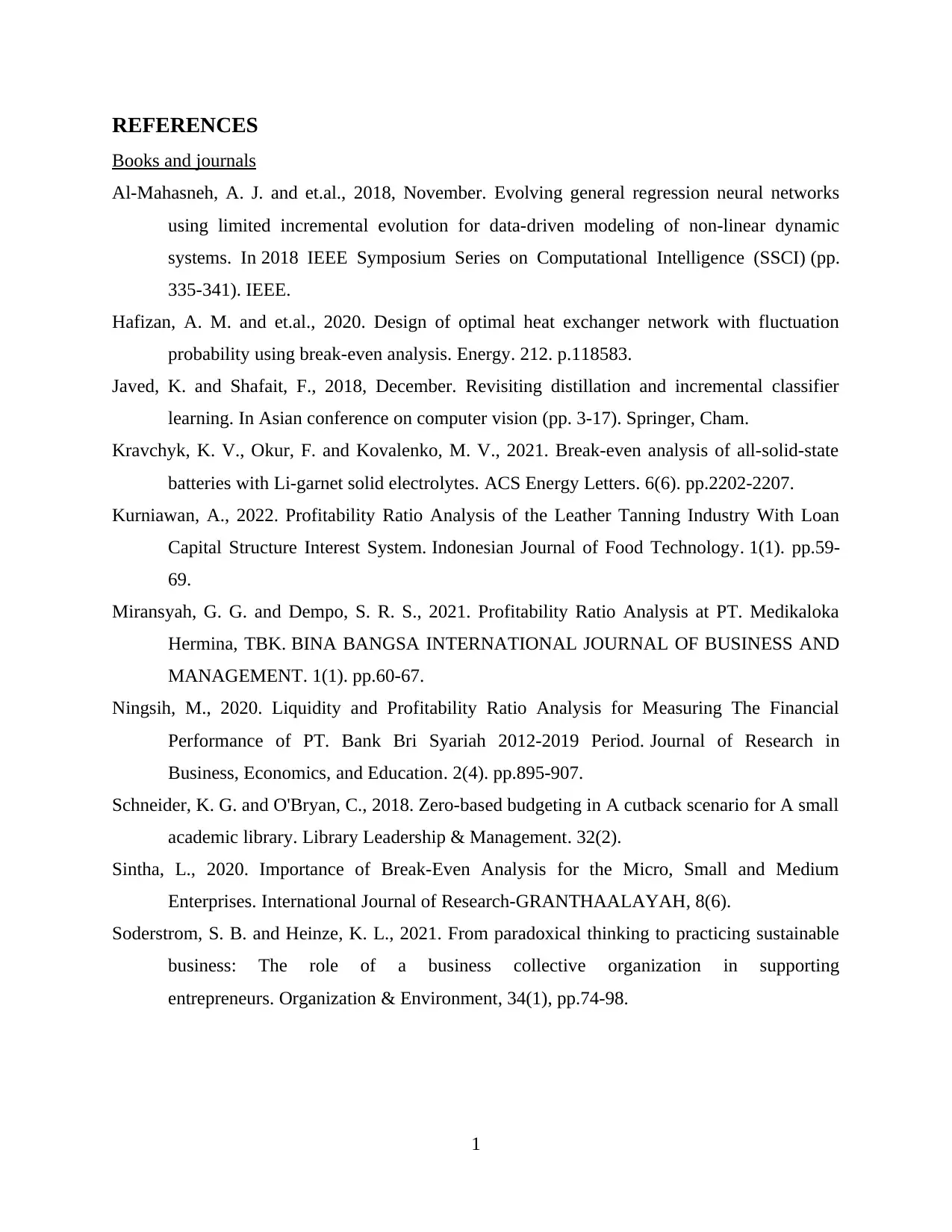
REFERENCES
Books and journals
Al-Mahasneh, A. J. and et.al., 2018, November. Evolving general regression neural networks
using limited incremental evolution for data-driven modeling of non-linear dynamic
systems. In 2018 IEEE Symposium Series on Computational Intelligence (SSCI) (pp.
335-341). IEEE.
Hafizan, A. M. and et.al., 2020. Design of optimal heat exchanger network with fluctuation
probability using break-even analysis. Energy. 212. p.118583.
Javed, K. and Shafait, F., 2018, December. Revisiting distillation and incremental classifier
learning. In Asian conference on computer vision (pp. 3-17). Springer, Cham.
Kravchyk, K. V., Okur, F. and Kovalenko, M. V., 2021. Break-even analysis of all-solid-state
batteries with Li-garnet solid electrolytes. ACS Energy Letters. 6(6). pp.2202-2207.
Kurniawan, A., 2022. Profitability Ratio Analysis of the Leather Tanning Industry With Loan
Capital Structure Interest System. Indonesian Journal of Food Technology. 1(1). pp.59-
69.
Miransyah, G. G. and Dempo, S. R. S., 2021. Profitability Ratio Analysis at PT. Medikaloka
Hermina, TBK. BINA BANGSA INTERNATIONAL JOURNAL OF BUSINESS AND
MANAGEMENT. 1(1). pp.60-67.
Ningsih, M., 2020. Liquidity and Profitability Ratio Analysis for Measuring The Financial
Performance of PT. Bank Bri Syariah 2012-2019 Period. Journal of Research in
Business, Economics, and Education. 2(4). pp.895-907.
Schneider, K. G. and O'Bryan, C., 2018. Zero-based budgeting in A cutback scenario for A small
academic library. Library Leadership & Management. 32(2).
Sintha, L., 2020. Importance of Break-Even Analysis for the Micro, Small and Medium
Enterprises. International Journal of Research-GRANTHAALAYAH, 8(6).
Soderstrom, S. B. and Heinze, K. L., 2021. From paradoxical thinking to practicing sustainable
business: The role of a business collective organization in supporting
entrepreneurs. Organization & Environment, 34(1), pp.74-98.
1
Books and journals
Al-Mahasneh, A. J. and et.al., 2018, November. Evolving general regression neural networks
using limited incremental evolution for data-driven modeling of non-linear dynamic
systems. In 2018 IEEE Symposium Series on Computational Intelligence (SSCI) (pp.
335-341). IEEE.
Hafizan, A. M. and et.al., 2020. Design of optimal heat exchanger network with fluctuation
probability using break-even analysis. Energy. 212. p.118583.
Javed, K. and Shafait, F., 2018, December. Revisiting distillation and incremental classifier
learning. In Asian conference on computer vision (pp. 3-17). Springer, Cham.
Kravchyk, K. V., Okur, F. and Kovalenko, M. V., 2021. Break-even analysis of all-solid-state
batteries with Li-garnet solid electrolytes. ACS Energy Letters. 6(6). pp.2202-2207.
Kurniawan, A., 2022. Profitability Ratio Analysis of the Leather Tanning Industry With Loan
Capital Structure Interest System. Indonesian Journal of Food Technology. 1(1). pp.59-
69.
Miransyah, G. G. and Dempo, S. R. S., 2021. Profitability Ratio Analysis at PT. Medikaloka
Hermina, TBK. BINA BANGSA INTERNATIONAL JOURNAL OF BUSINESS AND
MANAGEMENT. 1(1). pp.60-67.
Ningsih, M., 2020. Liquidity and Profitability Ratio Analysis for Measuring The Financial
Performance of PT. Bank Bri Syariah 2012-2019 Period. Journal of Research in
Business, Economics, and Education. 2(4). pp.895-907.
Schneider, K. G. and O'Bryan, C., 2018. Zero-based budgeting in A cutback scenario for A small
academic library. Library Leadership & Management. 32(2).
Sintha, L., 2020. Importance of Break-Even Analysis for the Micro, Small and Medium
Enterprises. International Journal of Research-GRANTHAALAYAH, 8(6).
Soderstrom, S. B. and Heinze, K. L., 2021. From paradoxical thinking to practicing sustainable
business: The role of a business collective organization in supporting
entrepreneurs. Organization & Environment, 34(1), pp.74-98.
1
⊘ This is a preview!⊘
Do you want full access?
Subscribe today to unlock all pages.

Trusted by 1+ million students worldwide
1 out of 13